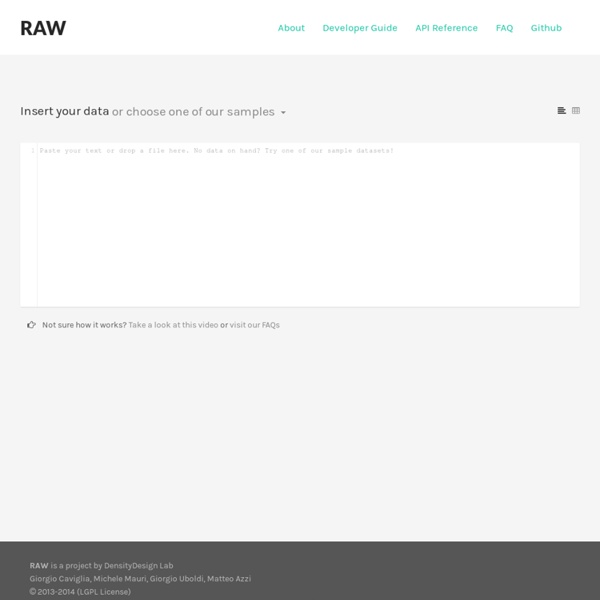



http://app.raw.densitydesign.org/#%2F
Related: DatavisualisationCreating Animated Bubble Charts in D3 - Jim Vallandingham Update: I moved the code to its own github repo - to make it easier to consume and maintain. Update #2 I’ve rewritten this tutorial in straight JavaScript. So if you aren’t that in to CoffeeScript, check the new one out! Recently, the New York Times featured a bubble chart of the proposed budget for 2013 by Shan Carter . It features some nice, organic, animations, and smooth transitions that add a lot of visual appeal to the graphic. How to Find the Right Chart Type for your Numeric Data 22 Feb 2016 Charts help you visualize numeric data in a graphical format but the problem is there are just too many types of charts to choose from. This diagram will help you pick the right chart for your data type.
Salary after Tax Calculator - Spain (ES) Nicholas Felton Tutorials · mbostock/d3 Wiki Wiki ▸ Tutorials Please feel free to add links to your work!! Tutorials may not be up-to-date with the latest version 4.0 of D3; consider reading them alongside the latest release notes, the 4.0 summary, and the 4.0 changes. Introductions & Core Concepts Find Latitude and Longitude Six maps that show the anatomy of America’s vast infrastructure - Washington Post D3js Voici le premier d’une longue lignée (je l’espère) de tutoriaux en français portant sur la librarie d3.js. Pour en savoir plus sur cette librairie reportez vous à la présentation que j’en ai faite sur ce post. L’objectif de ce premier tutoriel est de faire quelques exemples d’utilisation très simple de la librairie. A l’instart de Jquery, d3.js est une librarie qui permet de manipuler le DOM. Mais là où d3.js est très efficace est dans la manipulation de SVG. Manipuler ou créer une div avec d3.js
OpenRefine Data Visualization Libraries Based on D3.JS - Mike McDearmon There are a lot of ways to visualize data on the Web (with more emerging every day), but the flexibility, versatility, and energized development community surrounding D3.js makes it a great option to explore. The following list of D3 plugins, extensions, and applications below is by no means comprehensive, but oughta be enough to keep you busy for a while. If you’re just getting your feet wet with D3.js, here are some great learning resources to get you acclimated:D3 for mere mortals: Great introductory lessons for those starting from scratch.Try D3 Now: Another great resource for learning about core D3 concepts.Data-Driven Documents (paper): An academic article by Mike Bostock with loads of footnotes.Learning D3, Scott Becker: A quick and effective tutorial series to get yourself up and running.Dashing D3: A very thorough tutorial series covering a LOT more than just D3.Interactive Data Visualization for the Web is a fantastic book by Scott Murray.
Colorblind Web Page Filter Data Visualization 101: Pie Charts In our Data Visualization 101 series, we cover each chart type to help you sharpen your data visualization skills. Pie charts are one of the oldest and most popular ways to visualize data. This classic chart is the perfect example of the power of data visualization: a simple, easy-to-understand presentation that helps readers instantly identify the parts of a whole. Without further ado, here’s everything you need to know about the pie chart. What It Is
Textures.js Textures are useful for theselective perception of different categories View on Github Getting started